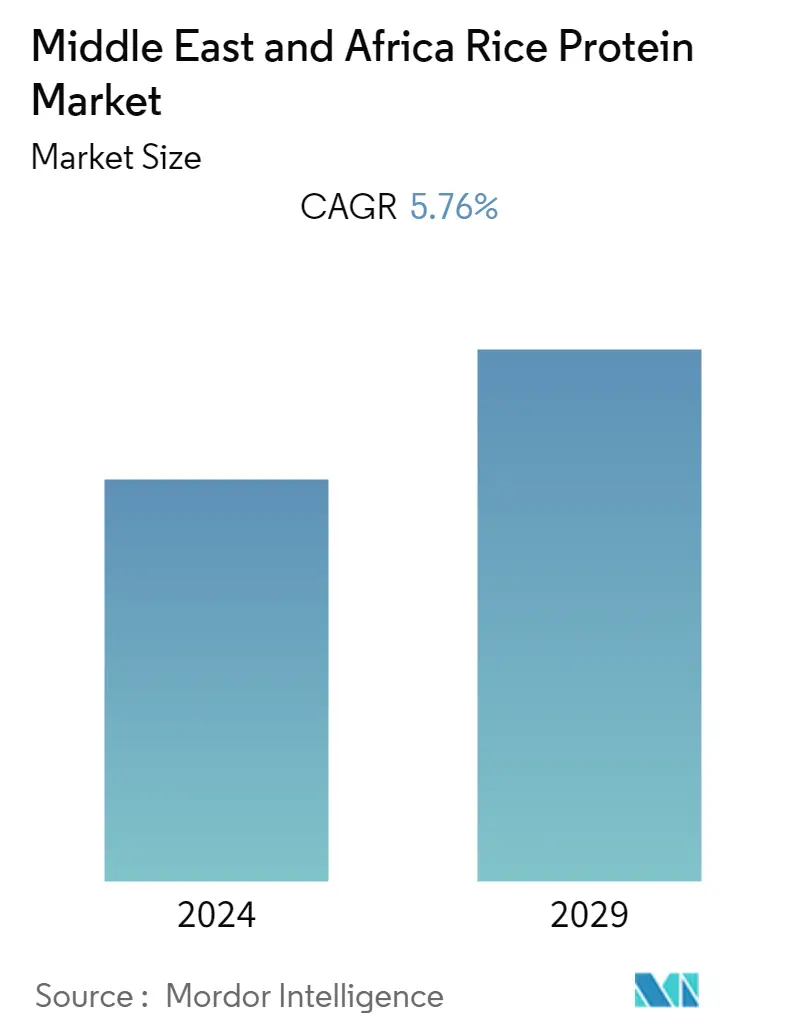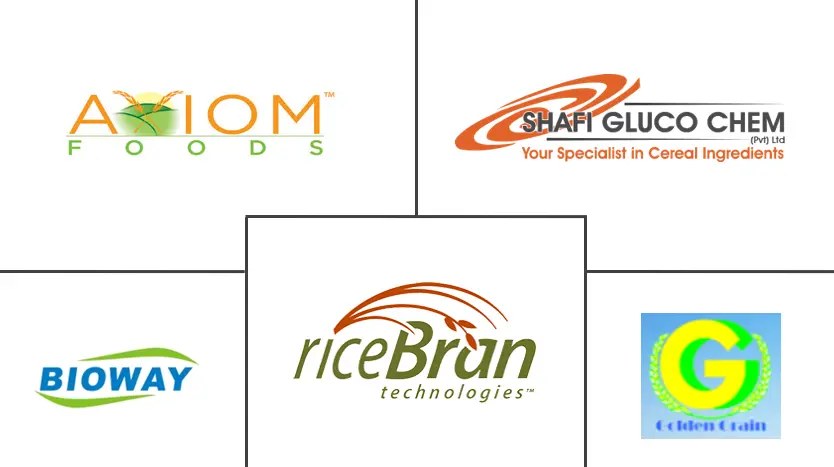Market Size of Middle East & Africa Rice Protein Industry

| Study Period | 2019 - 2029 |
| Base Year For Estimation | 2023 |
| Forecast Data Period | 2024 - 2029 |
| Historical Data Period | 2019 - 2022 |
| CAGR | 5.76 % |
| Market Concentration | Medium |
Major Players
*Disclaimer: Major Players sorted in no particular order |
MEA Rice Protein Market Analysis
The Middle East & Africa rice protein market is anticipated to witness a CAGR of 5.76% during the forecast period (2020 - 2025).
- The changing consumer lifestyles, evolving eating habits, and rigorous R&D on increasing demand for natural ingredients due to increasing consumer awareness are the prime reasons for the inflated demand for rice protein in the region.
- The health benefits associated with the rice protein also plays a vital role in the growth of the market and its increased application.
- The lifestyle modification has led to the consumers swaying away from conventional protein sources like whey, wheat protein, and soy protein that often lead to allergies to safer protein options in order to compensate for the daily required protein intake. Thus, the rising demand for less allergy-causing ingredients in processed foods is expected to drive the market in the region well in near future.
MEA Rice Protein Industry Segmentation
The Middle East & Africa rice protein market is segmented by product type rice protein isolate, rice protein concentrate, and others. Based on the application, the market is segmented as food and beverages, dietary supplements, and animal feed. The market is also classified by geography into Saudi Arabia, South Africa, and the Rest of the Middle East and Africa.
| By Product Type | |
| Rice Protein Isolate | |
| Rice Protein Concentrate | |
| Others |
| By Application | |
| Food and Beverages | |
| Dietary Supplements | |
| Animal Feed |
| By Geography | |
| Saudi Arabia | |
| South Africa | |
| Rest of the Middle East and Africa |
Middle East & Africa Rice Protein Market Size Summary
The Middle East & Africa rice protein market is poised for significant growth, driven by shifting consumer lifestyles and increasing awareness of natural ingredients. As consumers become more health-conscious, there is a notable shift away from traditional protein sources like whey, wheat, and soy, which are often associated with allergies, towards safer alternatives such as rice protein. This trend is further supported by the health benefits of rice protein, including its hypoallergenic properties and easy digestibility, making it an attractive option for post-workout recovery. The subtle taste of rice protein powder also enhances its appeal, allowing it to be seamlessly integrated into various functional food products, thereby improving their nutritional profile. The rising demand for less allergenic ingredients in processed foods is expected to propel the market forward, particularly in the Gulf countries where functional foods are gaining popularity.
Saudi Arabia, with its strong economy and high disposable income, is a key player in this market. The influence of Western culture and the increasing health consciousness among young adults have led to a surge in the consumption of premium and functional foods, including protein supplements. This has created a fertile ground for the growth of the rice protein market. The market is characterized by fragmentation, with numerous regional and multinational players vying for market share. Companies are focusing on geographical expansion, product innovation, and strategic partnerships to enhance their brand value. Manufacturers are also investing in new product development to create versatile rice protein solutions for multiple applications. This dynamic landscape offers ample opportunities for growth and experimentation, positioning the rice protein market as a promising sector in the region.
Middle East & Africa Rice Protein Market Size - Table of Contents
-
1. MARKET DYNAMICS
-
1.1 Market Drivers
-
1.2 Market Restraints
-
1.3 Porter's Five Forces Analysis
-
1.3.1 Threat of New Entrants
-
1.3.2 Bargaining Power of Buyers/Consumers
-
1.3.3 Bargaining Power of Suppliers
-
1.3.4 Threat of Substitute Products
-
1.3.5 Intensity of Competitive Rivalry
-
-
-
2. MARKET SEGMENTATION
-
2.1 By Product Type
-
2.1.1 Rice Protein Isolate
-
2.1.2 Rice Protein Concentrate
-
2.1.3 Others
-
-
2.2 By Application
-
2.2.1 Food and Beverages
-
2.2.2 Dietary Supplements
-
2.2.3 Animal Feed
-
-
2.3 By Geography
-
2.3.1 Saudi Arabia
-
2.3.2 South Africa
-
2.3.3 Rest of the Middle East and Africa
-
-
Middle East & Africa Rice Protein Market Size FAQs
What is the current Middle East & Africa Rice Protein Market size?
The Middle East & Africa Rice Protein Market is projected to register a CAGR of 5.76% during the forecast period (2024-2029)
Who are the key players in Middle East & Africa Rice Protein Market?
Axiom Foods, Inc, Bioway (Xi'an) Organic Ingredients Co., Ltd., Golden Grain Group Ltd., Shafi Gluco Chem Pvt., Ltd and RiceBran Technologies are the major companies operating in the Middle East & Africa Rice Protein Market.

